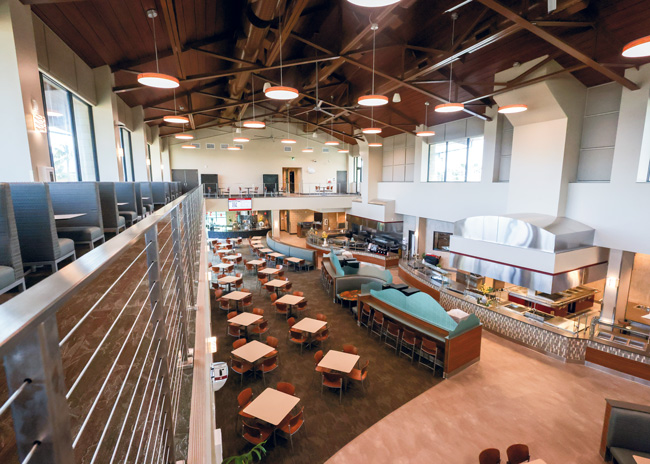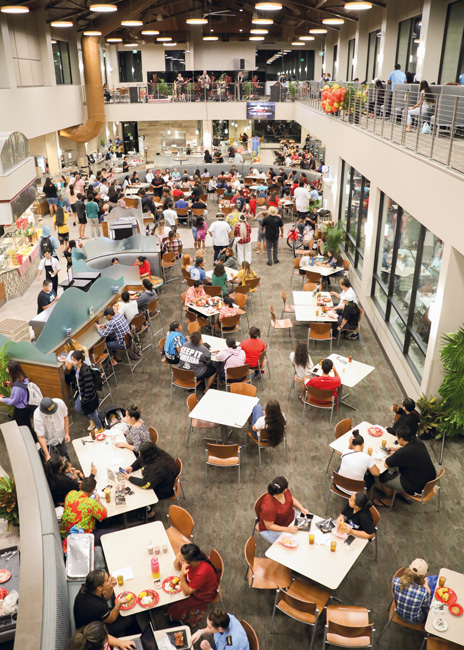FE&S appreciates the following professionals for generously contributing their time to judge this year’s competition:
Bill Davis, regional sales manager, Edward Don & Company, Woodridge, Ill.
Stuart Davis, principal, Stuart Davis Design, Park Ridge, Ill.
Beth Kuczera, president, Equipment Dynamics Inc., Chicago
Kristin Sedej, FCSI, president, S2O Consultants Inc., Chicago
Editor’s Note: Facility Design projects featured each month become eligible for the Facility Design Project of the Year competition. If you would like to submit a project for consideration, please contact Joe Carbonara at This email address is being protected from spambots. You need JavaScript enabled to view it..
 Photos by Monique Saenz, university photographer, University Communications
Photos by Monique Saenz, university photographer, University Communications
About the Project
Opened: April 20, 2022
Scope of Project: Dining hall new build includes back-of-the-house kitchen and front-of-the-house stations and seating. A second story includes seating, a beverage station, a private dining room and a tray Ferris wheel to transport trays down to the first level.
Size: 42,465 sq. ft.
Key Players
- Brigham Young University — Hawaii
- University president: John S.K. Kauwe III
- Director of Food Services: David Keala
- Banyan Dining Hall manager: Marilou Lee
- Executive chef: President Galea’i
- Catering assistant: Chad William Tuttle
- Director of Design, Planning and Construction: James R. Brown, AIA
- Brigham Young University — Provo
- BYU managing director of Dining Services: Dean Wright (retired after project completed)
- Architect: CRSA, Salt Lake City; E. Benjamin Rogers, AIA, NCARB (currently at another firm)
- Interior and lighting design: CRSA, Salt Lake City
- Foodservice consultant: Porter Khouw Consulting Inc., Crofton, Md.: David H. Porter, FCSI, CEO, president; Albin T. Khouw, senior vice president, emeritus
- Construction: Jacobsen Construction, Salt Lake City: Shawn Thomas, project director
- Equipment dealer: Restaurant & Store Equipment Company, Salt Lake City: LeGrande Steenblik, vice president
Why It Won: The Judges’ Comments
- This project was very focused and in maintaining the focus the team developed a specific set of goals they executed instead of trying to be all things to all people.
- The facility helps create a sense of community by bringing people together to dine and more.
- In a world where things are becoming more transactional and many consumers take their food to go, this design showcases the project team’s intention for people to stay in the facility and be together.
- The sustainability efforts went above and beyond the typical efforts in the college and university dining segment. For example, the facility uses food waste to feed pigs and create soap. These are unique initiatives that require a lot of thought and collaboration. At the end of the day, they also help drive the sense of community.
- The design clearly takes into account the needs and comfort of the staff, too.
- The project uses wood from the banyan tree in its furnishings. Little touches like this are found throughout the project and showcase an overall attention to detail.
- The warm design is respectful to the university’s natural surroundings. Allowing so much natural light into the space is always a good feature but even more so in this instance given the location of this university.
- The project accomplished so much yet it came in under budget. This shows excellent stewardship of the university’s funds.
- The use of plug-and-play equipment not only helped better manage the available funds, it also provided flexibility both now and in the future. This should make it easier to update specific pieces of equipment down the road should the menu or approach to service require it.
- The space is flexible by design, meaning it is suitable for catering and special events. The university hopes to expand in these areas.
- This facility is the result of an eight-year study. Carefully mining the data and minding the details led to a well-designed facility with great throughput.

The Project’s Purpose and Highlights
The Banyan Dining Hall project team sought to create a modern, culturally inclusive, and socially engaging dining facility that reflects the diversity of BYU — Hawaii’s student population. The facility also sought to address the growing demand for dining services on campus. The previous dining facility, built in 1960, was outdated and lacked the capacity to accommodate the increasing number of students. The new state-of-the-art dining hall had to foster community, social engagement and student well-being.
“The whole dining experience tells a story of the many cultures here at BYU — Hawaii and the importance of breaking bread together,” says Dean Wright, recently retired managing director of BYU Dining Services in Provo, Utah. “The dining facility is not about fusion. It brings people together and encourages them to learn others’ cultures but not lose your identity of where you came from. You can share your food and be proud of your culture and come together as one.”
The project took its shape from master planning led by H. David Porter, FCSI, president and CEO of Porter Khouw Consulting Inc., Crofton, Md., using the firm’s proprietary principle of social architecture. “We helped BYU — Hawaii and other schools to create safe spaces, strengthen social capital, foster new friendships, nourish student emotional well-being and increase student retention and academic success,” Khouw says. “As part of this we suggested a new approach for dining so the staff can produce food-to-order and in mass, depending on meal projections. And they can throttle up and down depending on peak/nonpeak hours. We suggested continuous service so students can come and go when they want. And changed to unlimited access meal plans.”
Primary Project Goals
 Accommodating future student growth. The facility was designed for 3,500 students initially but is scalable to 5,000 students without expanding the physical footprint.
Accommodating future student growth. The facility was designed for 3,500 students initially but is scalable to 5,000 students without expanding the physical footprint.
Enhancing the student dining experience by implementing continuous dining to allow students to eat on their own schedules.
Focusing on cultural representation by creating a design and menu concepts that reflect the diverse backgrounds of students from 70 countries across the Pacific Rim, the U.S. and other regions.
Providing operational efficiency by using a cooking suite that allows for both batch cooking and made-to-order meals, reducing food waste and improving service speed.
Emphasizing sustainability by incorporating waste reduction strategies like composting, growing in-house herbs, and repurposing used fryer oil into biofuel.
Design Challenges and Resolutions
This project is the result of eight years of research, planning, design, construction and more. As part of this thoughtful and thorough process, David Keala, director of Food Services, and members of the planning teams visited several colleges across the U.S. and Canada to identify best practices to integrate into Banyan Food Hall. This approach also allowed the project to overcome a variety of challenges.
For example, the facility sits in a central campus location with limited space, requiring a vertical design approach with two levels to maximize capacity. “We were challenged to design a new project for an irregular, constrained site in the middle of a functioning campus,” says James R. Brown, AIA, director of Design, Planning and Construction, BYU — Hawaii.
Construction of this project occurred during COVID-19, which introduced a variety of other challenges such as supply chain disruptions and material shortages. Through proactive planning and budget management, however, the project remained on track. “Even though we worked through one of the toughest times in history, the project still came in under budget, which was established prior to the pandemic,” says Shawn Thomas, project director, Jacobsen Construction, Salt Lake City.
 A cooking suite enables staff to work efficiently as they prepare a wide variety of menu items.
A cooking suite enables staff to work efficiently as they prepare a wide variety of menu items.
Classic Design Principles and Driving Efficiency into the Operation
Banyan Dining Hall’s layout follows a streamlined, linear workflow that promotes efficiency across the board.
A loading dock is positioned for easy delivery access. Ingredients are stored in walk-in refrigerators and freezers, near dedicated prep areas for cold and hot foods. The prep space features automatic slicers, bulk food processors and mixers. Cooking and production take place in a well-equipped back-of-the-house kitchen, featuring a 40-gallon tilt skillet, steamers, charbroilers and fryers.
In the front of the house, the thoughtful positioning of multiple serving stations allows for smooth guest flow. Culinary staff use the suite for both batch and made-to-order cooking, allowing the team to adjust to demand fluctuations. Also, locating back-of-the-house kitchen and prep areas behind serving stations allows for quick restocking and service.
The use of display cooking has allowed the team “to elevate our culinary offerings by providing our customers with a truly fresh and dynamic dining experience. This not only offers a unique show for our guests but also enables our chefs to showcase their culinary expertise in an engaging and exciting way,” says Executive Chef President Galea’i.
The dishwashing area sits strategically beneath, below the dining area, and an automated system transports used trays from the second floor to the dishwashing area.
The bakery sits adjacent to the dining area with large viewing windows, allowing students to observe the preparation of fresh bread and desserts. And self-cleaning blenders save time and labor in the smoothie and salad bar areas.
 The carving station enables guests to watch as staff carve proteins.
The carving station enables guests to watch as staff carve proteins.
In Their Own Words
Here, members of the BYU — Hawaii community share their perspectives on what makes this project so impactful.
“With nearly 70 countries and dozens of languages represented on campus, the Banyan Dining Hall has created a universal language through food,” says John S.K. Kauwe III, president of BYU — Hawaii. “The dining hall promotes unity and belonging on our campus by providing a welcoming and beautiful location for our students to gather, get to know each other and enjoy meaningful time together.”
Because of the new facility and the ability to prepare more food in the front of the house, staff added more special menus and events to foodservices’ offerings, says Marilou Lee, Banyan Dining Hall manager. The menu matches student demographics, especially those from Asia and the Pacific Rim. Examples include garlic rice with a Filipino breakfast sausage, longanisa, pork adobo, Thai chicken curry, and beef Pho, as well as pizzas, burgers and fries.
This culinary evolution is driven not only by the staff but also the students, furthering that sense of community the project sought to create. “This past fall semester, we had the privilege of empowering our student employees to contribute and share their cultural heritage through food that they help to prepare,” Galea’i says. “They were given the opportunity to create dishes and recipes from their home countries, and the process of exploring and combining authentic, unique flavors was both fun and rewarding for everyone involved. The recipes were then added to the menu, where they were met with enthusiastic approval from our customers. For many, it was a comforting reminder of home, helping them feel connected and supported.”
 Steam kettles and tilting kettles allow staff to prepare menu items in bulk.
Steam kettles and tilting kettles allow staff to prepare menu items in bulk.
A few themed events hosted in Banyan Hall: The Fête de la Tahiti, a celebration of Tahitian culture; The Pista sa Nayon, celebrating Filipino culture; and Polynesian Night, displaying Pacific Island Cultures. The stunning and welcoming space and atmosphere makes everything extra special.
“The joy and pride our student employees felt as they received positive feedback on their creations was truly inspiring,” Galea’i says. “The experience has not only fostered a deep sense of fulfillment but has also built confidence among our team. The stunning ambience and thoughtful design of our operational layout of the Banyan Dining Hall have contributed significantly to the overall success of our staff, elevating their work environment and reinforcing their sense of pride in their contributions.” Banyan Dining Hall has brought many positive changes, most important, improving the dining experience for students, employees and the community.
As a result of these efforts and more, Banyan Dining Hall serves more students and community members each day. This results in higher sales of about 8% to 10% per semester, according to Lee.
But guests are not the only ones happy about the changes. “Employees are proud to work in foodservices and at Banyan Dining Hall,” Keala says. “They take pride in their work and enjoy the environment thanks, in part, to the improved working space and environment. Dining service now employs more than 200 student employees in Banyan Dining Hall who work in various areas, such as the front of the house, production, catering, receiving and the accounting office. Strategic use of student employees, who work 19 hours per week, has reduced operational costs while providing work opportunities for those enrolled at the university.”
Galea’i speaks for just about everyone when he says, “I am incredibly grateful for the opportunity to work at BYUH Food Services and to be a part of the Banyan Dining Hall team. The experience has been enriching, motivating, and rewarding, and I am excited for the continued growth and success we will achieve in this incredible facility.”



